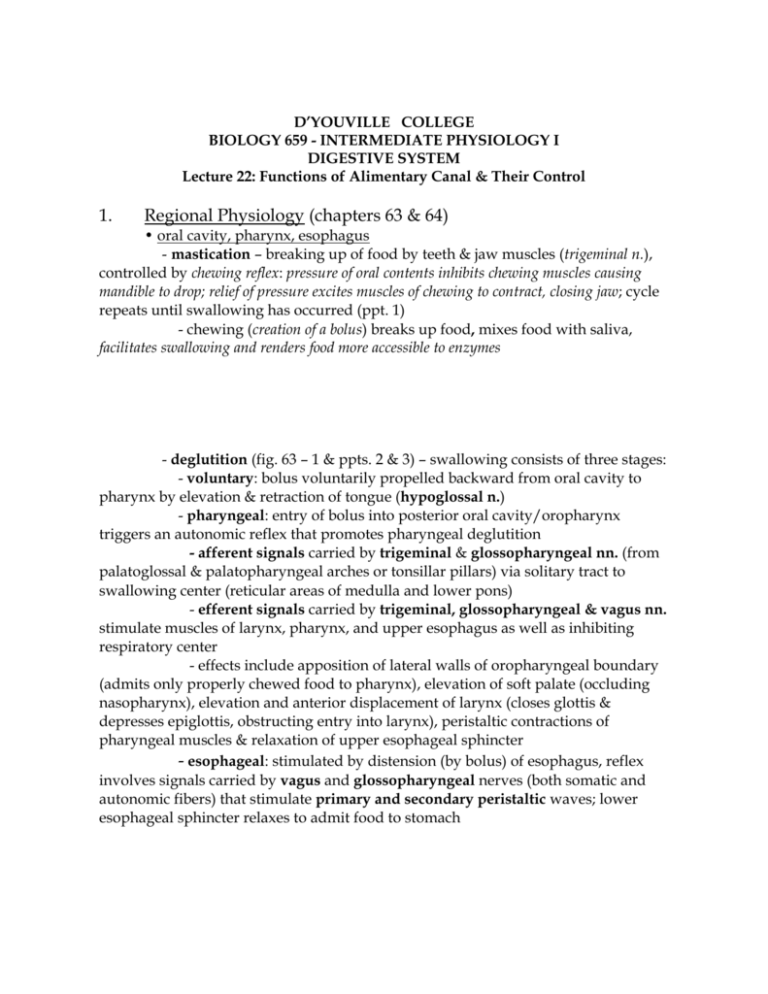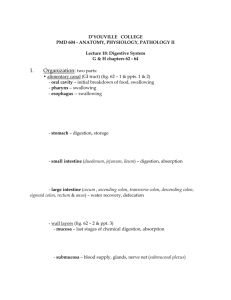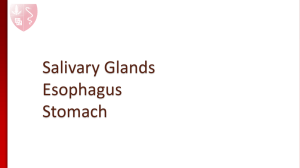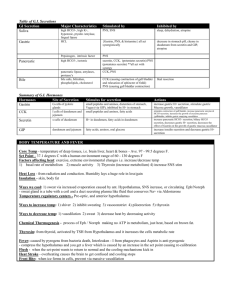22. GI physiol. 2
advertisement

D’YOUVILLE COLLEGE BIOLOGY 659 - INTERMEDIATE PHYSIOLOGY I DIGESTIVE SYSTEM Lecture 22: Functions of Alimentary Canal & Their Control 1. Regional Physiology (chapters 63 & 64) • oral cavity, pharynx, esophagus - mastication – breaking up of food by teeth & jaw muscles (trigeminal n.), controlled by chewing reflex: pressure of oral contents inhibits chewing muscles causing mandible to drop; relief of pressure excites muscles of chewing to contract, closing jaw; cycle repeats until swallowing has occurred (ppt. 1) - chewing (creation of a bolus) breaks up food, mixes food with saliva, facilitates swallowing and renders food more accessible to enzymes - deglutition (fig. 63 – 1 & ppts. 2 & 3) – swallowing consists of three stages: - voluntary: bolus voluntarily propelled backward from oral cavity to pharynx by elevation & retraction of tongue (hypoglossal n.) - pharyngeal: entry of bolus into posterior oral cavity/oropharynx triggers an autonomic reflex that promotes pharyngeal deglutition - afferent signals carried by trigeminal & glossopharyngeal nn. (from palatoglossal & palatopharyngeal arches or tonsillar pillars) via solitary tract to swallowing center (reticular areas of medulla and lower pons) - efferent signals carried by trigeminal, glossopharyngeal & vagus nn. stimulate muscles of larynx, pharynx, and upper esophagus as well as inhibiting respiratory center - effects include apposition of lateral walls of oropharyngeal boundary (admits only properly chewed food to pharynx), elevation of soft palate (occluding nasopharynx), elevation and anterior displacement of larynx (closes glottis & depresses epiglottis, obstructing entry into larynx), peristaltic contractions of pharyngeal muscles & relaxation of upper esophageal sphincter - esophageal: stimulated by distension (by bolus) of esophagus, reflex involves signals carried by vagus and glossopharyngeal nerves (both somatic and autonomic fibers) that stimulate primary and secondary peristaltic waves; lower esophageal sphincter relaxes to admit food to stomach Bio 659 lec. 22 - p. 2 - -secretions – stimuli that promote secretion include: 1) contact with mucosa; 2) chemical irritation of mucosa; 3) distension of wall of alimentary canal - some stimulation is a local effect on epithelial cells (via enteric nervous system); some involves autonomic (mostly parasympathetic) nerve reflexes and some involves hormonal reflexes - salivary glands (ppt. 4) include parotid, submandibular & sublingual + many smaller buccal glands; secretions range from watery (serous) to thick and sticky (mucous); saliva also contains numerous ions (bicarbonate, potassium, sodium, chloride) that vary in concentration, enzymes that commence chemical digestion (salivary amylase or ptyalin) or that combat bacteria in oral cavity (e.g. lysozyme) - cranial nerves VII and IX (facial & glossopharyngeal) carry sensory limb of reflex via solitary tract to salivatory nuclei, which send parasympathetic fibers (in nerves VII & IX) to major salivary glands (fig. 64 – 3 & ppt. 5) • stomach (fig. 63 – 2 & ppt. 6): - storage (up to 1.5 liters) is facilitated by an initial relaxation in response to distension - mixing is accomplished by weak peristaltic (constrictor) waves accompanied by tonic contraction of pyloric sphincter (may cause retropulsion) - emptying – more intense peristaltic waves ‘pump’ chyme into duodenum; controlled by stretching (enteric nervous system), gastrin (+), enterogastric reflex (-) and cholecystokinin (-) (ppt. 7) Bio 659 lec. 22 - p. 3 - - secretions – tubular glands (fig. 64 – 4 & ppt. 8) of the stomach mucosa include mucous neck cells (mucus), parietal cells (HCl & intrinsic factor), chief cells (pepsinogen) & G cells (gastrin); most of the surface mucosal cells secrete mucus - acid secretion (fig. 64 – 5 & ppt. 9) appears to be stimulated by gastrin and by post-ganglionic parasympathetic neurons (stomach’s enteric nervous system) - pepsinogen secretion is stimulated by acid and by parasympathetic fibers - mucus secretion (alkaline) is stimulated by direct contact of mucosa with food or irritation of the mucosa - phases of gastric secretion (fig. 64 – 7 & ppt. 10) – cephalic: sight, smell, taste or even thought of food initiates parasympathetic signals via vagus nerve to stimulate gastric secretion - gastric: entry of food into stomach stimulates a vagovagal reflex and gastrin secretion; each of these stimulates gastric juice secretion - intestinal: enterogastric signals (via enteric nervous system), cholecystokinin, gastric inhibitory peptide & secretin) all inhibit secretion of gastric juice











